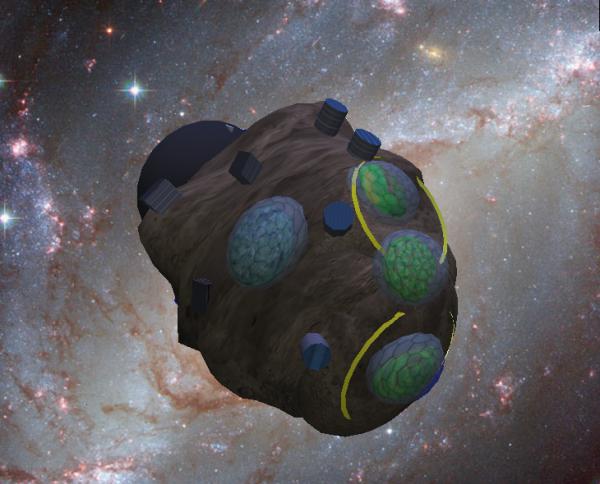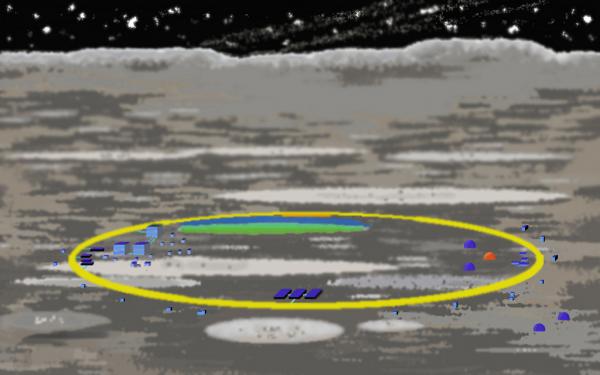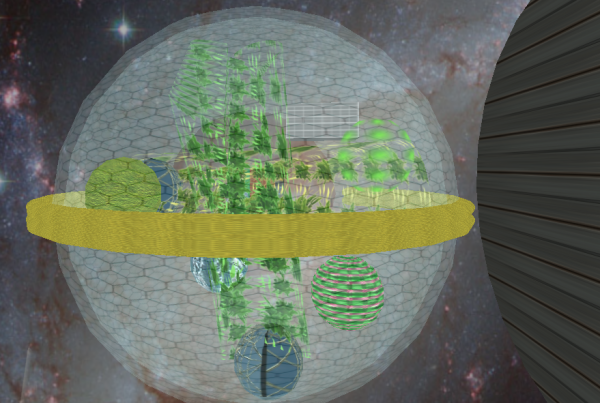BY LETTER
Tracked Centrifuge
Technology > Technology Levels > High Tech / Hitech
Technology > Technology Levels > Middle Tech / Midtech
Technology > Technology Levels > Middle Tech / Midtech
System used on low-gee worlds to simulate higher gravity | |
 Image from Wesley Bruce | |
| On this Asteroid two (yellow) tracked centrifuges can be seen, as well as domes for microgravity cultivation and several cylindrical buildings for microgravity recreation and industry. The black structure on the back of the asteroid is a solar furnace for power and metal smelting. The green domes are lit by free floating mirrors located behind the camera. This asteroid supports 10000 people. | |
A tracked centrifuge or banked track centrifuge is a solution to artificial gravity on moons and large asteroids that have some gravity but not enough to maintain bone development and density. On such a world the local gravity prevents a cylinder or toroidal centrifuge from functioning. However a train going around a corner exhibits significant inertial forces on the passengers and in some cases fast trains have tilted or banked in order to deal with this force.
The tracked centrifuge uses this as a gravity substitute. The track is generally perfectly circular, 1 kilometer in radius and banked at an angle that produces a tangential outward force of 0.8 to 1 g when the local gravity and the centrifugal force vectors are summed. Generally this means a speed of 300 - 356 kph and either wheels with linear motor assistance, full magnetic levitation or later Utility fog based flowing surfaces. The carriages on the track are generally pressurized and interconnected but not a continuous rigid ring.
Unlike other centrifuges used for artificial gravity this one can start and stop regularly to allow large numbers of people to come and go, and for maintenance purposes. Most rotate on their long axis when the carriage stops so that the floor of the carriage is always down. Most carriages in such a system are gym carriages that allow a person to exercise for a few hours a week to maintain normal Terragen bone density parameters. People do not need to live on the train permanently to gain its benefits.
The first such systems were built on Luna in 196 AT. The test track was at the south polar colony. It was recessed into a trench and eventually shielded with a fused regolith roof. The system served the population of the moon for about 20 years. 7 more were built at different colonies as Luna populations grew. While other medical and technological solutions exist to bone loss in low or zero gravity environments many choose centrifugal gravity solution as a natural solution. However the advocates of the other solutions point out that hurtling along at ~300 km per hour with tons of rock less than a meter away is far from natural or truly safe. There has however only been one significant accident.
By tradition the buried track is marked in yellow after the Luna six accident. A construction earth mover unintentionally dug into the track way causing the carriages on the track to come to a catastrophic stop. 300 people were injured but there were no fatalities. The Luna medical facilities were taxed to the limits and were significantly up graded in expectation of other such accidents. However the expedient paint job worked and no subsequent accidents are known. In many cases where the warning is redundant because the track is very deep or very well armored the paint is still used. Its become a tradition and a form of artistic expression.
As other solutions took hold other carriage types are added to the tracks. The track is generally 3.14 kilometers long and so its rare for a track to be full of gym carriages. Other carriages were added to fill the track out. These included restaurant carriages, which allowed many meals that don't work well in low gravity to be cooked and eaten. Spar and pool carriages for "the authentic terrain bathing experience", creche carriages for gravity tolerant baby development and eventually some apartment carriages are added to most systems. Where apartment carriages are used the systems hit an interesting problem. Stopping and starting the carriages at night produced sleep disorders. Often this results in a curfew after 9.00 UTC when the carriage does not stop for 8 hours. If you miss that curfew you are either stuck on or off the carriage for the night. Most apartment tenants have alternative accommodation in the form of low g apartment and storage annexes attached to the tracks boarding bays. Generally the Luna carriages are 3 meters wide and 7 long. While this may seems rather confining many components are capable of folding away and the walls often have virtual windows technology with artificial views and dynamic Trompe-l'œil. Some carriages have provision for full virtual reality cave operations.
 Image from Wesley Bruce | |
| An early tracked centrifuge on Luna | |
At the time of the Great Expulsion all 8 track ways were used to their limits providing for refugees. As a consequence millions came to revere them as their saving technologies while others came to hate them as part of their ordeal. Many took stories to the stars of them. The apartments were converted to gyms in many cases. Several hundred tracked centrifuges were built on various asteroids and zero gravity habitats to accommodate the refugees. Generally historians of the technology tend to favor the higher population numbers relating to the population surviving both the technocalypse and subsequent expulsion since the numbers built and their distribution don't correspond well to the lower numbers or records.
 Image from Wesley Bruce | |
| A tracked centrifuge system wrapped around a small microgravity Freesphere. Twin trains run in opposite directions within the yellow ring, which is shielded with water tanks, storage spaces and space slag. The Sphere has a double geodesic shell with water in the gap for shielding and thermal control. The internal spheres are farms with shielded stowage for zero g planters. The geodesic spheres entire volume is pressurised as a large zero g recreational habitat | |
Where the track is used in a zero g habitat the carriages run around at 90° to the plane of the ring, a true centrifuge or gravity ring however the carriages are still segmented and still stop regularly so it is still defined as a train or a tracked centrifuge. Generally the carriages are wider than the ones on Luna. Sharsec 23 has 10 tracks in a boring 2 kilometer cube with each carriage being 30 m wide, 60 m long and two stories high favoring apartment carriages. The catch is that the Sharsec are supposed to have been wiped out in 623 AT in a battle with the GAIA Archailect. The Sharsec population itself is divided on the question of their origin.
Tracked centrifuges have been declared obsolete a dozen time over the centuries but the technology keeps reappearing. The main reason is that its a low mass and low cost solution to artificial gravity that can be built in weeks in an emergency. Quite a few of the early interstellar colony ships were essentially giant fuel tanks with a few zero g habitats and one or two tracked centrifuges on the surface. The steam punk enthusiasts of the NoCoZo make extensive use of the technology because, quote, "its a train in space; how could they resist". In this case the carriages tend to take what's called the traditional 18th century look; wood, brass and leather. However these steam punk space stations are not primitive and the outer shell of the carriages and tracks are very robust with a smattering of Transapientech material for safety. Hiders are also assumed to use the technology since a track buried deep in a small planetoid is much harder to detect than a large spinning structure, though the only confirmed case is the Tau Surprise colony that came out of hiding in 2443 AT.
The largest system is found on Grees Lae a massive dyson swarm of primary vec population which built on/in the surface of one of their smaller Computronium nodes a tracked system with one track per face, six in total, with the track width of 600 meters and carriage parameters of 580 meters wide, 870 long and 8 stories high. There are a thousand carriages in total per track. All of this was expediently fabricated for base line visitors and diplomatic use when the swarm matured. Most carriages are largely empty parkland and private estates with a few farms.
One similar system is the Milos Hub of the Pascal Fleet. This trading hub is a McKendree Cylinder project that went broke before one end was finished. It does not rotate. The fleet inherited the failed project as a shipping debtor. Since then their ships have used it for maintenance and trading. They cruse around the inside at speeds needed to maintain 0.7 g. However while the physics is similar the technology differs in several ways. The ships are not interconnected, and can change lanes. Smaller vessels are used to travel between them. The ships use magnetic landing grapples to reflect off the aluminum 2 surfaces for lift but thrust is provided by rocketry systems. Fuel is also shipped in by smaller craft. One lane leads to a 2 kilometer hole that allows the ship to run off the edge to launch clear of the station. Landing on the open edge of the structure is a routine maneuver. However some of the ships have been on the Hub for decades and are unlikely to leave soon. Some of the largest vessels in the fleet have tracked centrifuges on board though the fleets main solution is the two body spin.
The total number of systems is unknown. Its rare for them to be fully utilized. Standard designs are rarely successful with artistic expression highly favored. The technology is so iconic that there are even versions found in some virtual worlds and full emulations of several designs are possible using utility fog based Polymorphic Architecture systems. However its detractors still often class it as a train to nowhere.
Related Articles
- Gravity - Text by M. Alan Kazlev
One of the fundamental physical forces of nature, it binds objects together on the macroscopic scale. Mass produces a gravitational force, which attracts all other masses. The more massive an object, the stronger the gravitational force. The late Industrial/early Atomic Age physicist Einstein showed in his theory of general relativity that gravity can be explained in terms of local curvature of space-time. - Gravity Assist Manoeuvre - Text by M. Alan Kazlev
Also gravity assist fly-by; gravitational slingshot. The use of a large celestial object (such as a planet, star, or black hole)'s gravity in order to change a spacecraft's trajectory. In a close encounter with a large object, a small part of the object's orbital energy is transferred to the spacecraft. Very useful with low energy or limited propulsion space flight (especially late atomic and Information Age, and some long-distance probes ever since. Nowadays it is also favoured by some vacuum-adapted clades for sporting purposes. - Gravity Balloons
- Gravity Tug
- Microgravity - Text by M. Alan Kazlev
A state in which gravity is reduced to virtually negligible levels. For example, when an object is in free fall, it experiences microgravity. It is deleterious to baseline physiology, but space-adapted tweaks can survive a microgravity environment indefinitely.
Appears in Topics
Development Notes
Text by Wesley Bruce
Initially published on 05 May 2015.
Initially published on 05 May 2015.






